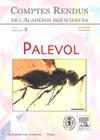在欧洲acheulen的早期阶段,用于打击乐器的尖端宏观工具?Bois-de-Riquet的us4案例(lezignan -la- cebe, herault,法国)
IF 1.3
4区 地球科学
Q3 PALEONTOLOGY
引用次数: 6
摘要
Bois-de-Riquet考古遗址的US4级代表了一个可追溯到中更新世早期的泥石流型矿床。它产生了由玄武岩、长石和石英组成的丰富的岩石组合,其组成部分代表了所有的生产操作链:岩心、薄片、锤、加工鹅卵石和块,以及双面面。后者与大薄片的生产有关,证明了欧洲阿舍利的第一阶段。本文介绍了部分玄武岩宏观工具的分析。该方法基于人工制品的技术-形态-功能和痕迹分析,以及特定实验参考框架的创建。这些方法允许我们区分五种工具类型。三组工具在其切削刃和夹持区之间呈现横向对立,而其他两组工具呈现斜向对立。这些功能结构涉及不同的手势。然而,这些文物的大小和重量特征,以及切割边缘的角度,使我们能够提出一种直接发射打击的行动模式。这一假设在木材和新鲜骨头上进行了实验测试,一方面验证了这些工具在这些活动中的有效性,另一方面,分析了切割边缘上产生的损伤,并将其与考古工具进行了比较。实验获得的数据支持了这五组锋利的宏观工具中使用发射冲击的假设。我们讨论这些结果的含义为表征的第一阶段的欧洲阿舍利。事实上,除了双面的存在之外,生产大块薄片作为工具支撑可能被认为是欧洲的一种技术创新,可能是认知秩序进化的特征。与此同时,在发射的打击乐器中使用这些锋利的工具可能表明,古人类正在以新的方式利用他们的环境。最后,本文为关于欧洲阿舍利语起源的争论带来了新的反思因素。本文章由计算机程序翻译,如有差异,请以英文原文为准。
Du macro-outillage tranchant utilisé en percussion lancée dans les premières phases de l’Acheuléen européen ? Le cas de l’US4 de Bois-de-Riquet (Lézignan-la-Cèbe, Hérault, France)
Level US4 of the Bois-de-Riquet archeological site represents a mudslide type deposit dating to the early Middle Pleistocene. It has yielded a rich lithic assemblage made from basalt, aplite and quartz, whose components represent all of the operating chains of production: cores, flakes, hammers, worked cobbles and blocks, as well as a biface. The latter, associated with the production of large flakes, testifies to the first phases of the European Acheulian. This article presents the analysis of part of the macro-tools made from basalt. The methodology is based on a techno-morpho-functional and traceological analysis of the artefacts, coupled with the creation of a specific experimental frame of reference. These approaches allow us to distinguish among five tool types. Three groups of tools present a transverse opposition between their cutting edges and gripping zones, while the other two groups present an oblique opposition. These functional structures refer to different gestures. However, the size and weight characteristics of the artefacts, as well as the angle of the cutting edges, allow us to propose a mode of action in direct launched percussion. This hypothesis was experimentally tested on wood and fresh bone to verify, on the one hand, the effectiveness of these tools for these activities and, on the other hand, to analyze the damage produced on the cutting edges and compare it to the archeological tools. The data obtained experimentally support the hypothesis that launched percussion was used in these five groups of sharp-edged macro-tools. We discuss the implications of these results for the characterization of the first phases of the European Acheulean. Indeed, beyond the presence of a biface, the production of massive flakes as tool supports may be perceived as a technological innovation in Europe, possibly characterizing an evolution of cognitive order. At the same time, the use of these sharp tools in launched percussion could indicate that hominins were exploiting their environments in new ways. Finally, this article brings new elements of reflection to the debate on the origins of the European Acheulean.
求助全文
通过发布文献求助,成功后即可免费获取论文全文。
去求助
来源期刊

Comptes Rendus Palevol
地学-古生物学
CiteScore
2.10
自引率
0.00%
发文量
39
审稿时长
17.6 weeks
期刊介绍:
Comptes Rendus Palevol is a fully electronic and peer-reviewed journal, with a continuous publication stream, devoted to palaeontology, prehistory and evolutionary sciences. It publishes original research results, in French or English, in the following domains: systematic and human palaeontology, prehistory, evolutionary biology and macroevolution, and history of sciences. Thematic issues may also be published under the responsibility of a guest editor. All articles published in Comptes Rendus Palevol are compliant with the different nomenclatural codes. A copyright assignment will be signed by the authors before publication.
 求助内容:
求助内容: 应助结果提醒方式:
应助结果提醒方式:


